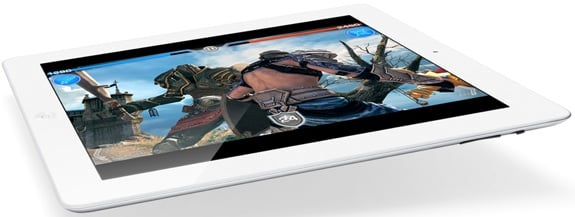Find Our Latest Video Reviews on YouTube!
If you want to stay on top of all of our video reviews of the latest tech, be sure to check out and subscribe to the Gear Live YouTube channel, hosted by Andru Edwards! It’s free!
Wednesday March 2, 2011 11:16 pm
Here’s why iPad 2 didn’t get a Retina Display

In the lead-up to the iPad 2 announcement, many were predicting that Apple would give the tablet's 9.7-inch screen a bump in resolution. But when Steve Jobs revealed the second-generation iPad to the world, it had the same pixel count as the first one: 1,024x768, even though the display was revamped to be considerably thinner. Why no extra pixels?
Looking at the history of the display on the iPhone offers some clues. Apple kept the display of the iPhone at the same 480x320-pixel resolution for the first three versions of the phone, and when it finally upgraded the display for the iPhone 4, the bump was huge, doubling the display resolution to 960x640 pixels. The upgrade also introduced the term "retina display," a piece of marketing jargon that Apple doesn't quantify, but generally means a display that is better than the limits of human vision.
The Power of Two
One likely reason that Apple did a very simple "times two" to the iPhone display was to make things easy for app developers. By simply doubling the vertical and horizontal pixel counts, app makers were able to easily update their apps for the new resolution.
"Apple likes to do things in increments of two," says Raymond Soneira, president of DisplayMate Technologies, who has done analysis of the iPhone and iPad displays. "You had to do it for the iPhone because the iPhone 3GS had a low resolution [compared to other phones]. When you have a very low resolution it's hard to do any increase that's not a factor of two."
But upgrading the iPad similarly would present problems. If Apple doubled the iPad resolution, app developers might have things mathematically simple, but the resolution would jump to 2,048x1,536—many more pixels than needed for even the full HD video (1,920x1,080).
"It's really unnecessary," says Soneira. "Technically, you don't really have to double. At a high resolution it's easier to re-scale an image. [Apple] could theoretically go to 1,600x1,200, and apps that were designed [for the lower resolution] could be rescaled by the graphics processor and look quite good."
On top of pixel overkill, increasing the resolution by that much would introduce a host of issues. The cost of the display would be higher, number one. With so many pixels, the iPad's processor would be taxed more as well, so Apple would have to make compromises with battery life to keep the thin design. On top of that, brightness of the display would probably suffer.
"As you increase the number of pixels, the light throughput on the panel goes down," explains Soneira. "Processing power needed goes up dramatically, since the number of pixels goes up by a factor of four. You'd take a hit on battery life, at least."
The benefits, on the other hand, are questionable. A video in 1080p format wouldn't even take up the entire screen on a retina-display iPad, and Apple probably wouldn't be able to make claims like "9x faster graphics" if the A5 processor had to drive such high resolutions.
"You don't really need a retina display for an iPad," Soneira says. "It's actually held further away from your face, typically, than an iPhone, so it doesn't need as high a resolution. Technically it would not make sense. It would be too sharp. Even the iPhone 4 is really sharper than it needs to be."
Not Even a Little Bump
That explains why iPad 2 doesn't have a retina display, but why no bump at all? Prior to the unveiling Soneira had guessed that Apple might take the resolution up to 1,152x768 and change the aspect ratio to 3:2, making the screen shaped more like the iPhone and bringing the pixel count closer to its competitors like the
Clearly Apple didn't do that, and it's probable Apple had considered and rejected an iPhone-like aspect ratio for the first iPad. While Apple didn't respond to a query about the lack of upgrade to the iPad 2 screen, rumors circulated just before launch that Apple had run into "engineering issues" with a higher-resolution display.
"Apple is buying these things in tremendous quantities," Soneria says. "And I know that from working with manufacturers that it's really hard to get a lock on large quantities of display panels without significant advance planning. It could be that they simply could not secure panels in the quantities they needed."
More Pixels for iPad 3?
So the second-generation iPad keeps the same resolution as the first, but most of the gadget's other specs have been upgraded. Will the third-generation iPad, which some have said could come as early as this fall, get a pixel bump? No one outside of Apple knows, but Soneira has a recommendation for Apple on the iPad 3 screen.
"I think by fall, 1,024x768 will start to look tired. So [the iPad] is going to get pushed by all the competition as well. It's starting to look like the iPhone 3GS where they kept the resolution at 480x320 for maybe one cycle too long."
This article, written by Peter Pachal, originally appeared on PCMag.com and is republished on Gear Live with the permission of Ziff Davis, Inc..
Latest Gear Live Videos
Advertisement
Advertisement
Advertisement
© Gear Live Inc. {year} – User-posted content, unless source is quoted, is licensed under a Creative Commons Public Domain License. Gear Live graphics, logos, designs, page headers, button icons, videos, articles, blogs, forums, scripts and other service names are the trademarks of Gear Live Inc.











